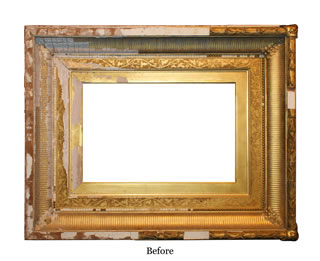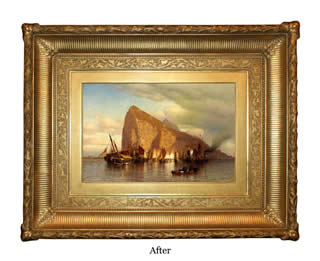Frame Restoration
Eli Wilner & Company is the leading frame restoration expert. We are a preferred provider for both AXA and Chubb fine art insurance, and we have been chosen to perform frame restorations for the most prestigious public and private art collections. Eli Wilner & Company has completed hundreds of complex frame restorations for private collectors and public institutions. Increasingly, curators, dealer, collectors, and aficionados embrace the aesthetic and historical value of period frames. With a 10,000 square foot studio, the Wilner expert carvers, gilders, and mold-makers are able to complete a remarkably wide range of projects, including those that smaller studios cannot accommodate.
Recent years have seen a revolution take place in the way the American period frame is perceived. As awareness of the period frame as an important decorative object in its own right increases, curators, collectors and dealers are re-evaluating their views. This includes mounting exhibitions, presenting symposiums and carefully considering issues of frame conservation and frame restoration.
According to The New York Times article Letting the Frame Speak for the Artist, “Mr. Wilner, the framer, said his restoration work had increased five-fold during the last year, as museums with tight budgets for new acquisitions concluded that this was ‘an economical way to dress up their collections.’” Read the full article here http://nyti.ms/1ii5Ids.
The guiding principle of frame restoration is to return the object to its original form, or at least to a near semblance of it. Wherever possible, all vestiges of the original should be preserved, as such elements are valuable clues to the original appearance of the object and are the reference point for any frame restoration effort.
The three main components which require attention in the proper maintenance and conservation of period frames are the structural support, which is usually made of wood, the surface decoration or ornament and the gilded surface. Consolidation of the wood substructure generally involves rejoining open corners, repairing cracks and splits, and strengthening weakened areas. These repairs should be made with minimal change to the original appearance of the woodwork. It is important to preserve any evidence of the maker's marks, such as labels or inscribed identification. As in the study of furniture, these elements provide documentation of a frame's design and construction.
The surface decorations and ornament of a frame are generally comprised of applied ornament, and are most often gilded. The surface decoration of a frame generally incorporates several layers applied to the structural support. Decorative ornament made of composition or "compo" often requires special attention. Traditional compo is a mixture of chalk and resins which, by the early 19th century was widely used in place of the labor-intensive process of hand carving. Frequently, design elements must be cast from existing areas, and sections of loss or damage must be replaced. The frame's gilded surface is the third component that must be carefully considered as part of the overall frame restoration process. Gold leaf is generally applied to a gesso ground, which is composed of gilder's whiting and hide glue. Gold leaf is sometimes applied directly to the wood surface without first applying a layer of gesso (often it is gold on oak). If there are losses in the original gesso, or if the gesso is separating from its substructure, the surface should be reapplied where necessary, in conformity with the original design. In properly restoring gilded surfaces, the original gold leaf should be preserved, if at all possible. After the gold leaf has been applied it is then burnished.
Finally, the original patination should be replicated where necessary throughout the regilded surfaces of the frame. If there is no trace of the original, it is best to refer to the characteristic treatment of contemporaneous examples.
As with the restoration of paintings, sculpture and decorative objects, restoration of frames is best performed by experienced craftsmen who understand and respect the historic integrity of the object. It is not surprising then, that many of the processes used in frame conservation and frame restoration studios today are the same as those used for centuries. Hand carving and traditional water gilding methods allow for the faithful treatment of frames initially created using these same methods. Whether for museums, institutions or private collectors, the need for skilled frame restoration and conservation methods is more critical today than ever. As the connoisseurship of period frames continues, every framer has a responsibility to his clients to be aware of the many considerations in proper conservation and frame restoration.
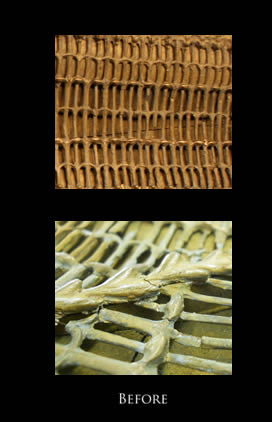
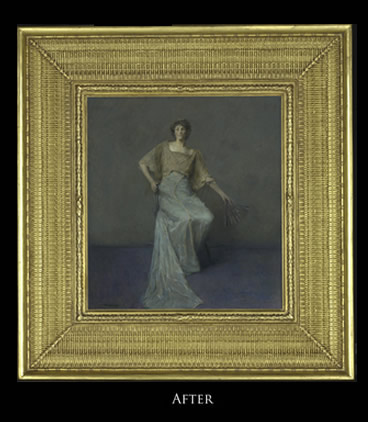
This period frame is a beautiful example of a floating grille frame design by Stanford White. Over time, the grille had become broken and distorted, and the crispness of the ornament had been severely eroded. The entire grille element had to be removed and recreated in its original (flat) contour. The re-creation was done using the same techniques as the original, including the internal wire reinforcement. The grille section was then gilded, re-applied to the frame, and the correct patina was achieved.
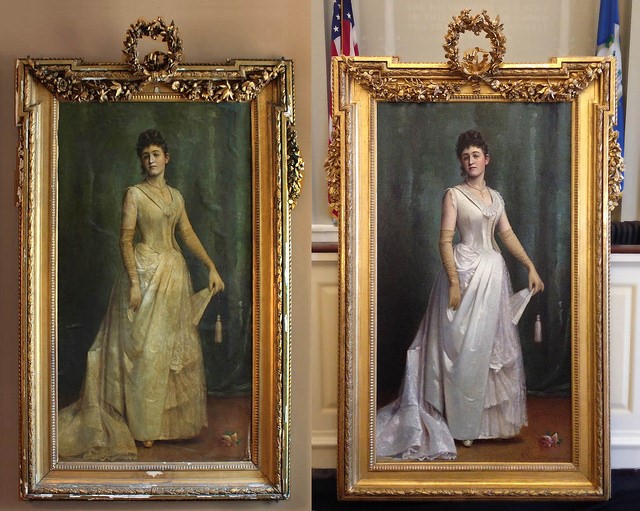
The elaborate frame on this massive portrait of Carrie Welton from the Mattatuck Museum required extensive stabilization, replacement ornament, and re-gilding. The frame restoration was completed in 2013.
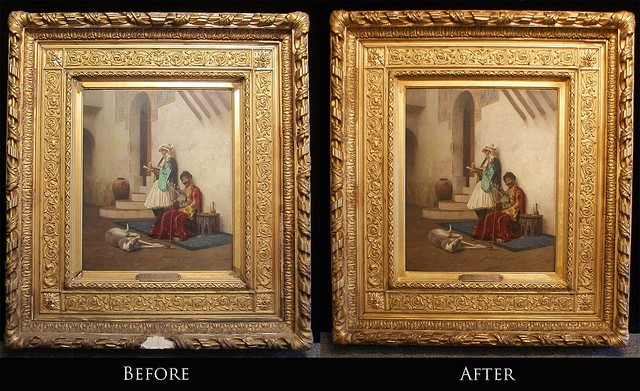
In 2014, Eli Wilner & Company collaborated with the Lyndhurst Mansion staff in a massive re-installation of this Historic Site’s Grand Picture Gallery. This frame on a painting by Gerome could have benefited from a complete restoration, but it was agreed that only the one missing significant missing ornament would be dealt with due to time limitations.

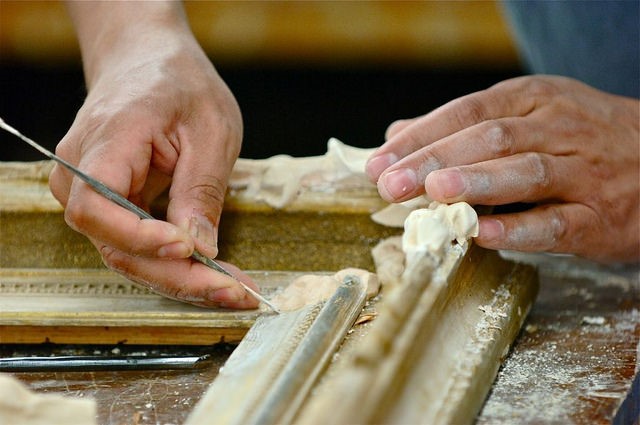
The main elements of frame restoration: wood carving, gilding, and mold-making , are often assumed to be vanishing arts, making a visit to the Eli Wilner & Company studio a unique destination for everyone from art students and museum donor groups to collectors and dealers. To arrange a private event/tour with live demonstrations, or to get a quote on a frame restoration project please email info@eliwilner.com or call us at 212‑744‑6521.









